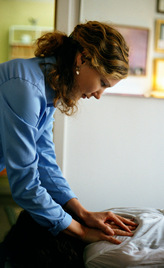| Sylvia Skefich, D.C. |
|
Chronic
ache or pain? What do you do without wasting a lot of time or
money? Here are some tips to get the best results in the least
time:
Remove aggravating factors Sometimes this is easy to figure out, as in "Ow! It hurts when I ride my bike for over an hour!" But often, it is not clear what is causing a chronic or recurring pain. If the pain is fairly constant, then suspect any and everything that you do every day (or nearly every day). You must scrutinize your activities (work and play), your postures (rest, work, driving and play), and your intake (food, supplements, and medications–they can add to certain pain problems like low back, groin pain, and sciatica). Eliminate or minimize each possible suspicious activity for at least a week, one at a time, starting with the most likely ones. For instance, for someone struggling with a chronic sore neck, then get rid of that tall pillow when sleeping on the back or on the side, or the too flat pillow when side sleeping. If that doesn’t work, then try something else. For someone with hip pain, stop using the treadmill (or stairmaster, etc.)–you can always start up again if you don’t improve in a week. Notice if you feel better when you are on vacation…is it the different bed?…the different diet?…the lack of sitting?…the lack of work-related activity? It is possible to identify an aggravating activity by using the scientific, simple approach of elimination. Remember, for chronic pains, the culprit activity is usually something you do nearly every day, and thus tend not to suspect it because it is routine. Add ameliorating or pacifying activities This will depend on the problem. If the culprit is repetitive motion, then bracing and ergonomic changes to minimize the motion are required. If the problem involves muscle strain, then anti-inflammatory approaches are useful, such as ice, wrapping, and topical ibuprofin cream (which is easier on the liver and kidneys then ingested anti-inflammatories). If there is simply unexplained pain, pacifying and cleansing foods can help decrease whole body inflammation and sensitivity. More vegetables, less toxins (coffee, alcohol, sugar) can make a big difference. Also, turmeric, the yellow herb, decreases inflammation, which can then decrease pain. Glucosamine sulfate, which helps to lubricate and build cartilege, can act as a pain reliever in some people. There are other products which can be explored. Try trusted name brands, and ask advice from those you trust. Get professional help from someone you trust If you are not making enough progress, don’t suffer, get help. There are people who specialize in getting people better. They can make faster headway than working by yourself. You may need specific bodywork, stretching or strengthening recommendations or insight into your lifestyle to make the changes you need in good speed.
|
Doctor of Chiropractic, Sylvia Skefich – Santa Cruz, California 831-475-1995 |
